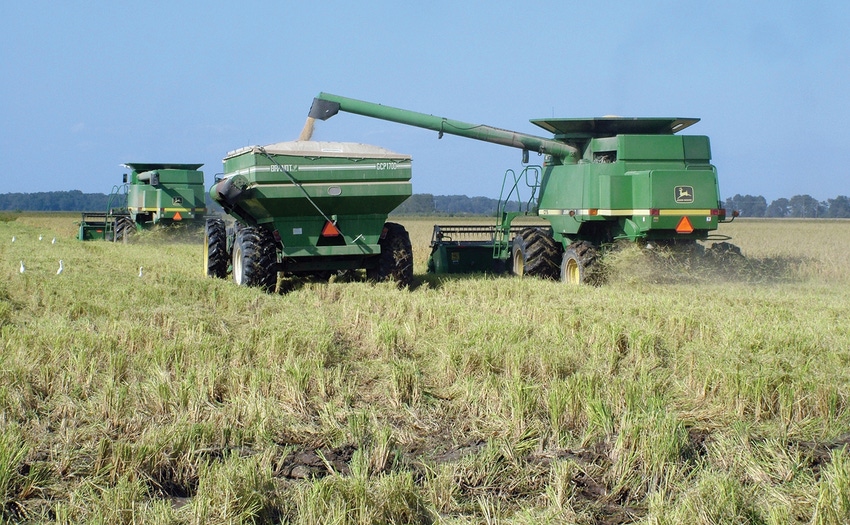
What might Mid-South rice acres look like in 2017?
From an Arkansas perspective, “as long as soybean prices remain as strong as they currently are — and rice prices stay as low as they currently are — we’re probably looking at around 1.2 million rice acres,” says Jarrod Hardke, University of Arkansas Extension rice specialist. “That’s close to a 20 percent decrease from 2016 when we were at about 1.5 million acres.
“I’m a rice guy and want that crop planted,” says Hardke. “But with soybean prices where they are, I’ve been strongly encouraging growers to book some. We don’t have to book a lot and want to leave some options open. But I’d book some soybeans now to cover the cost of production. Lock that good price down while you can.”
The past few years, the state’s rice acreage “has really been see-sawing. In 2016, we were up around 18 percent over 2015 acreage, which was down 13 percent compared to 2014.
“We’ll probably be close to 50 percent of our 2017 rice being hybrid. That isn’t a big jump — recently, we’ve been in the 40s.
“Last year, we were somewhere in the neighborhood of 8 percent planted to medium-grain. That’s likely to rise in 2017 because of the yield stability last year and some market demand which should increase acreage to around 15 percent.”
That leaves 35 percent of Arkansas’ rice acreage split among Clearfield and conventional varieties.
Common threads
Asked about current questions and concerns from rice producers during winter meetings, Hardke says, “There are definitely some common threads. As belts tighten, growers want increasingly more specific guidance on their options.
“Individual growers have very different mindsets entering 2017. That’s because things were so ‘all over the board’ in 2016, mostly in a bad way. You hear everything from ‘we did fine’ to ‘the environment for rice wasn’t so good’ to ‘my crop was horrible.’
“More or less, though, the hybrids and medium-grain rice were off up to 20 bushels below expectations. The varieties were more like 40 bushels off.”
Hardke says it isn’t likely the same environmental conditions will happen again. “But people are moving to a defensive crouch, and rightly so. That means they want more hybrid rice, but there isn’t more to be had. There were all sorts of difficulties on the Gulf Coast — RiceTec had as much trouble as many of our growers did with seed production.
“Some will grow whatever hybrid seed they can get and plant nothing else. Some have been asking me about filling in with medium-grains even if they aren’t traditional medium-grain growers.”
The biggest question: after hybrids and medium-grains, what do I plant? What varieties will work?
Conventionals
“We have a few recommended conventionals and a few Clearfields. There won’t be a large acreage of a lot of any newer, first-time-commercially-available varieties this year.”
On the conventional front, “Diamond is our most recommended. Since it’s the first year out, plant it with caution. Look at history and there are plenty of examples where, despite rigorous testing, true field conditions expose weaknesses. We really work at it, but it’s impossible to expose varieties to everything, every environment in the state, during testing. Always use caution when planting any new cultivar for the first time. Put a toe in the water, don’t do a cannonball.”
There will likely be around 75,000 to 100,000 acres of Diamond. “That’s a pretty big jump for a new release.”
More producers will be familiar with LaKast, because it has been out for several years. “It was released into the teeth of 2015 and 2016, so there were wide result variations from individual growers. Some guys loved it, some had no luck with it. However, compared head to head, it was the most stable variety in the face of the tough environmental conditions.
“I think growers will shift away from Roy J after what happened in 2016. The rains came in late and caused some pretty bad blast on it. In some cases with a lack of blast disease being found, fungicide applications weren’t made or were minimized and the disease came back to bite us late.”
Taggart, meanwhile, “has very limited availability with most phasing it out. It’s still one our more dependable varieties, though.”
Clearfield considerations
On the Clearfield side, “the new CL153 looks like it has high-end yield potential. It’s similar to CL151, which has been a staple for us over the years. However, CL153 brings a much-improved disease package over CL151 including increased resistance to blast and bacterial panicle blight. It has a lot of positives and, with any luck, it’ll be a big player. I’m guessing there may be enough seed to plant around 50,000 acres this year.”
Another new Clearfield, CL172, “will likely also have limited acreage — maybe another 50,000. This variety can sometimes reach the same yield heights as the other Clearfields. Typically, though, it places between CL151 and CL111.
“Like CL153, CL172 has a great disease package. The yield just lags a bit although the grain quality is phenomenal.”
Medium-grains
Regarding medium-grains, “Jupiter has been our staple since about 2010. It’s been fantastic with high yields but has some blast and lodging concerns. Growers are looking for some improvements and Titan is a new release that looks to be competitive with Jupiter.”
Hardke is waiting on some market approvals before recommending Titan over Jupiter. “Those approvals may come in the next month or two. Assuming that happens, I’d tentatively make that recommendation because the data says it yields more than Jupiter on average, has an equal-to-slightly-better disease package, stands up better, and heads five to seven days earlier.”
About the Author(s)
You May Also Like




